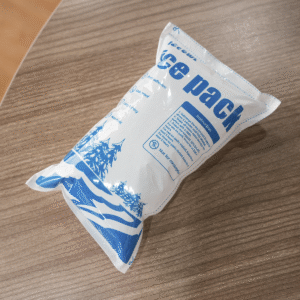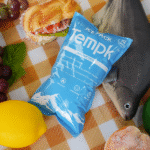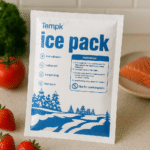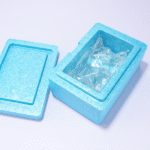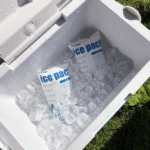Ensuring the efficacy of vaccines during transport is critical, as even slight temperature fluctuations can compromise their effectiveness. Dry ice packs are an essential tool in the cold chain logistics of temperature-sensitive vaccines. These packs ensure that vaccines remain within the required temperature range throughout transit, preserving their potency and safety. In diesem Artikel, we will explore the role of dry ice packs in vaccine transport, ihre Vorteile, and the best practices for using them in 2025.
-
Was sind Trockeneisbeutel?, and how do they work for vaccine transport?
-
What are the benefits of using dry ice over other cooling methods for vaccine shipping?
-
How do businesses ensure safety and compliance when using dry ice packs in vaccine transport?
-
What are the latest trends and innovations in dry ice usage for cold chain logistics?
Was sind Trockeneisbeutel?, and How Do They Work for Vaccine Transport?
Trockeneis ist die feste Form von Kohlendioxid, and it sublimates directly from a solid to a gas at a temperature of -78.5°C (-109.3° F). This unique property allows dry ice packs to maintain extremely low temperatures, which is crucial for transporting vaccines that require storage at ultra-low temperatures. Im Gegensatz zu herkömmlichem Eis, welches schmilzt und Wasserverunreinigungen verursachen kann, dry ice does not leave any residue, making it ideal for maintaining the cold chain during vaccine transport.
When placed in insulated containers, dry ice absorbs heat from the surrounding environment, creating a consistent and cold atmosphere to protect temperature-sensitive vaccines. The slow sublimation process ensures that vaccines remain within the critical temperature range for extended periods, whether during domestic or international shipments.
How Do Dry Ice Packs Maintain Consistent Temperature During Transport?
Trockeneis sublimiert langsam, releasing cold gas that absorbs heat from the surrounding air. This process maintains a steady temperature environment, making it highly effective for keeping vaccines below freezing. Depending on the amount of dry ice used, temperatures can be maintained for up to 72 Stunden oder mehr.
| Temperaturkontrollmethode | Zeitrahmen | Wirksamkeit | Praktische Anwendung |
|---|---|---|---|
| Trockeneis | 24-72 Std. | Hochwirksam | Long-haul vaccine transport |
| Gelpackungen | 12-24 Std. | Mäßig | Kurzstreckentransporte |
| Eisbeutel | Variiert | Niedrig bis mittel | Suitable for non-temperature-sensitive products |
Real-Life Examples of Dry Ice Packs in Vaccine Transport
-
Szenario 1: A healthcare provider uses dry ice to transport vaccines to rural areas, ensuring that the vaccines remain viable even with limited access to refrigeration.
-
Szenario 2: An international logistics company specializing in pharmaceutical shipments uses dry ice to maintain the cold chain for global vaccine distribution.
Fall aus dem wirklichen Leben: A logistics provider in Europe successfully transported COVID-19 vaccines using dry ice packs, ensuring that vaccines remained within the required temperature range throughout the long international journey, mit a 100% success rate in preserving their efficacy.
What Are the Benefits of Using Dry Ice for Vaccine Shipping?
Schlüsselvorteile
-
Effective Long-Term Cooling: Dry ice can maintain ultra-low temperatures for an extended period, which is essential for vaccines that require freezing conditions, wie mRNA-Impfstoffe.
-
Ungiftig und sicher: Im Gegensatz zu Gelpackungen, dry ice does not leave any liquid residue that could damage vaccines or packaging. Es sublimiert direkt zu Gas, Reduzierung des Risikos einer Kontamination.
-
Versatile Shipping: Dry ice is adaptable for small-scale and large-scale shipments, and the amount used can be adjusted depending on the specific needs of the vaccine.
Zusätzliche Vorteile
-
Kosteneffizienz: Although the initial cost may be higher than some cooling methods, the use of dry ice can reduce losses due to spoilage, leading to long-term savings.
-
Reduced Spoilage and Losses: Durch die Aufrechterhaltung konstanter Temperaturen, dry ice helps to ensure that vaccines reach their destination without compromising quality.
Sicherheitsaspekte beim Umgang mit Trockeneis
Handling dry ice requires careful attention due to its extremely cold temperature and the risk of CO₂ buildup. The following safety precautions should be observed when using dry ice for vaccine transport:
-
Belüftung: Ensure that all containers are vented to release CO₂ gas to prevent pressure buildup that could cause rupture.
-
Schutzausrüstung: Personnel should wear insulated gloves and safety goggles when handling dry ice to prevent frostbite and eye injury.
-
Richtige Speicherung: Dry ice should never be stored in an airtight container. Always store it in a well-ventilated area.
How Dry Ice Packs Compare to Other Cooling Methods
Dry ice is the best solution for vaccines requiring deep-freeze conditions, wie mRNA-Impfstoffe. Jedoch, for vaccines that only need refrigeration (2-8°C), gel packs or phase change materials (PCMs) are suitable alternatives. Hier ist ein kurzer Vergleich:
| Kühlmethode | Temperaturbereich | Kühldauer | Regulatorische Überlegungen |
|---|---|---|---|
| Trockeneis | -78.5°C | Bis zu 72 Std. | Classified as hazardous material; requires IATA and CFR compliance |
| Gelpackungen | 2-8°C | Bis zu 24 Std. | No special hazardous classification |
| PCMs | 2-8°C, -20°C, or custom ranges | Varies based on PCM type | Can be used for non-ultracold vaccines |
Latest Trends and Innovations in Dry Ice Usage for Vaccine Transport
Nachhaltige Trockeneisproduktion
In 2025, dry ice production is becoming more sustainable, with innovations like carbon capture methods helping to reduce environmental impacts. Companies are exploring more eco-friendly production methods to meet the increasing demand for cold chain logistics.
Echtzeit-Temperaturüberwachung
With the growing importance of precise temperature control, real-time monitoring technology has become a critical part of vaccine transport. IoT-enabled sensors are now being used to continuously track the temperature of vaccine shipments, ensuring that they stay within the required range.
Frequently Asked Questions About Dry Ice and Vaccine Transport
Q: How long do dry ice packs last for vaccine transport?
A: Dry ice packs typically maintain their cooling power for 24-72 Std., depending on the quantity of dry ice and the quality of insulation used.
Q: Ist trockeneis sicher zu handhaben?
A: While dry ice is safe with proper precautions, it must be handled with care. Always use gloves and ensure that storage areas are well-ventilated to prevent CO₂ buildup.
Schlussfolgerung und Empfehlungen
Zusammenfassend, dry ice packs are essential for transporting vaccines that require ultra-low temperatures. Their ability to maintain consistent and cold temperatures for extended periods makes them indispensable in the cold chain logistics industry. Businesses involved in vaccine transport should invest in dry ice solutions to reduce spoilage, ensure compliance with regulations, and improve the reliability of their shipping processes.
Nächste Schritte
To optimize your vaccine transport processes, start by evaluating your current cold chain logistics. Consider working with a logistics provider that specializes in dry ice and other cold chain solutions to ensure the safe and effective delivery of vaccines.
Über Tempk
Tempk ist ein führender Anbieter fortschrittlicher Kühlkettenlösungen, specializing in dry ice packs and insulated shipping containers for the transportation of pharmaceuticals and biologics. We are committed to providing safe, effizient, and environmentally responsible solutions that help businesses meet their cold chain logistics needs.
Contact us today for expert advice on optimizing your vaccine transport logistics!






